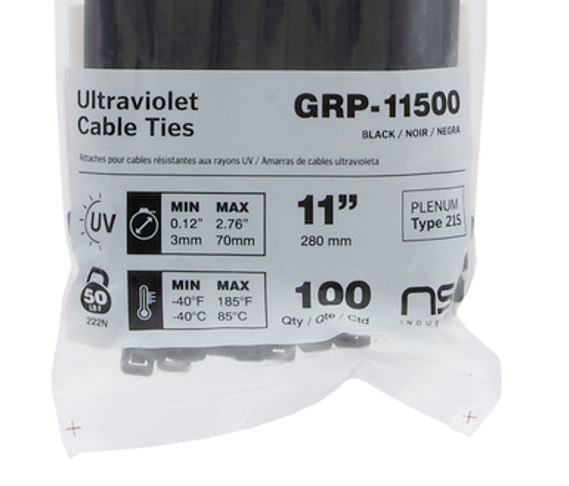There are some versatile tools that everyone should keep on hand for tackling jobs around the home or doing electrical work in the field. Classic examples include duct tape, a utility knife, or even a hammer — but those aren’t even the simplest solutions. Sometimes, you need cable ties. You may hear them referenced as wire ties or zip ties, so we'll break down the details.

If you’ve ever wrestled with a bundle of wires while doing electrical installation (or when setting up your entertainment center!) you know the struggle of keeping wires secured and out of the way. That’s the same problem Maurus C. Logan saw in 1958 while touring a Boeing manufacturing facility. Workers were fighting to keep wires secure inside the planes by tying them to plywood with nylon cord. This experience led Maurus to invent the first cable tie.
The standard modern wire cable tie uses a simple and reliable mechanism. The body of the tie has a distinctive serrated shape and the head features a small tooth, usually called a tongue or pawl. When you feed the tie’s tail through the head, the pawl grips onto each ridge in turn and locks the tie down at whatever size you need.

What are the Tiebreakers Between Cable Ties?
Most modern ties are made from nylon, but that doesn’t mean they’re created equal. There are many different formulations of nylon, but the best choice for many cable ties is nylon 6,6. Nylon 6,6 is abrasion-resistant and has a higher inherent tensile strength and melting point than nylon 6, leading to durable ties that stand up to extreme elements.
Besides variance in material, cable ties can also come in a huge variety of styles, colors, lengths, strengths, and performance ratings. For example:
- Type 21 ties are good for general use
- Type 21S ties offers superior strength for suspending cables from mounts
- AH2-rated ties are specially tested for use in air handling plenum spaces


When selecting your cable ties, make sure to shop from a brand like PowerGRP® that offers a full range of ties to ensure you have the best product for the job at hand. This line of professional-grade cable ties from NSI Industries also includes special performance features like a bent tip for easier insertion and UV-resistant black options.
For bundling cables, affixing wires to beams or pipes, or even making repairs around the home, it’s important to select a cable tie with the proper length. Cable ties can range from just a few inches to several feet long—PowerGRP, for example, ranges all the way from 6” to a massive 60”! Pick the right length, then trim the excess tail to keep a tidy workspace.
The next element to keep in mind is tensile strength. Some ties can be snapped by hand, while others can hold the full weight of a person. For PowerGRP, that range extends all the way up to a verified 250lb tensile strength rating. Overkill for taming your television cables, but necessary for demanding industrial jobs!
Checklist for Choosing the Perfect Tie:
- Tensile strength: how much force can these ties endure?
- Minimum and maximum bundle sizes: what length do I need?
- Material construction: is this temperature rated for my job?
- Design innovations: does this tie improve on the classic design?
Tying up Loose Ends
For some jobs, a normal cable tie won’t do. There are ties specially designed for every job, like metal-detectable ties for use in food packaging, options rated for extreme heat or cold, or impact and vibration resistant ties to get a grip on machinery. Select a tie designed for your application to guarantee reliable performance.


Cable ties are the most efficient way to bundle or secure cable in construction, but that is far from their only use! Here are our top five other cable tie applications:
- Securing automotive or aircraft components
- Organizing wires in utility enclosures
- Temporary bundling for construction or manufacturing
- Safely wiring consumer electronics
- Securing electrical conduit piping or ducting
A bent tail tip and self-locking head allow professionals to install ties much faster, keeping jobs moving and clients happy. Since cable ties are such an integral part of a commercial electrician’s toolkit, modern brands like PowerGRP design cable ties with improvements to the classic shape.
Of course, speed isn’t the only measure of success. A reliably strong connection that is code compliant is a necessity when using cable ties, especially in professional applications. Ensure that your project is up-to-code and strong enough to stand the test of time by buying a professional-grade brand, preferably from a reliable electrical supply distributor like Wiseway.
Wiseway Supply is a family-owned and locally-operated distributor with over 50 years of experience servicing the southern OH and central KY region. We stock a wide variety of industry-leading brands like PowerGRP, offering products that commercial and residential contractors actually use. Just like you, we want our customers to have the best experience possible.
When selecting what cable ties to use, keep in mind the information included here. When selecting where to buy them—choose Wiseway Supply. Shop today to see how we place customer service as our top priority.

If you want to stay in the loop about Wiseway's monthly events, promotions, blog posts, and more, sign up for Wise Bites!

